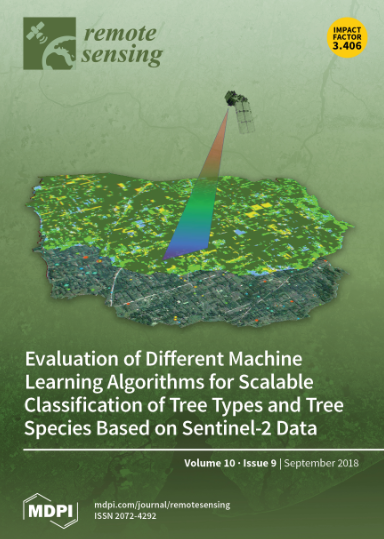Full scale assessment of pansharpening methods and data products
IF 4.1
2区 地球科学
Q2 ENVIRONMENTAL SCIENCES
引用次数: 55
Abstract
Quality assessment of pansharpened images is traditionally carried out either at degraded spatial scale by checking the synthesis property ofWald’s protocol or at the full spatial scale by separately checking the spectral and spatial consistencies. The spatial distortion of the QNR protocol and the spectral distortion of Khan’s protocol may be combined into a unique quality index, referred to as hybrid QNR (HQNR), that is calculated at full scale. Alternatively, multiscale measurements of indices requiring a reference, like SAM, ERGAS and Q4, may be extrapolated to yield a quality measurement at the full scale of the fusion product, where a reference does not exist. Experiments on simulated Pl´eiades data, of which reference originals at full scale are available, highlight that quadratic polynomials having three-point support, i.e. fitting three measurements at as many progressively doubled scales, are adequate. Q4 is more suitable for extrapolation than ERGAS and SAM. The Q4 value predicted from multiscale measurements and the Q4 value measured at full scale thanks to the reference original, differ by very few percents for six different state-of-the-art methods that have been compared. HQNR is substantially comparable to the extrapolated Q4.全面评估pansharpening方法和数据产品
传统的泛锐化图像质量评估要么在退化空间尺度上通过检查wald协议的合成特性来进行,要么在全空间尺度上通过分别检查光谱和空间一致性来进行。QNR协议的空间失真和Khan协议的频谱失真可以组合成一个独特的质量指标,称为混合QNR (HQNR),在满量程下计算。或者,需要参考的指数的多尺度测量,如SAM, ERGAS和Q4,可以外推,在不存在参考的情况下,在融合产品的全尺度上产生高质量的测量。模拟Pl´eiades数据的实验,其中参考原件在全尺寸是可用的,强调二次多项式具有三点支持,即拟合三个测量在尽可能多的逐步加倍的尺度,是足够的。Q4比ERGAS和SAM更适合外推。对于已经比较的六种不同的最先进的方法,多尺度测量预测的Q4值与参考原始的全尺度测量的Q4值相差很少。HQNR基本上与外推的Q4相当。
本文章由计算机程序翻译,如有差异,请以英文原文为准。
求助全文
约1分钟内获得全文
求助全文
来源期刊

Remote Sensing
REMOTE SENSING-
CiteScore
8.30
自引率
24.00%
发文量
5435
审稿时长
20.66 days
期刊介绍:
Remote Sensing (ISSN 2072-4292) publishes regular research papers, reviews, letters and communications covering all aspects of the remote sensing process, from instrument design and signal processing to the retrieval of geophysical parameters and their application in geosciences. Our aim is to encourage scientists to publish experimental, theoretical and computational results in as much detail as possible so that results can be easily reproduced. There is no restriction on the length of the papers. The full experimental details must be provided so that the results can be reproduced.
 求助内容:
求助内容: 应助结果提醒方式:
应助结果提醒方式:


